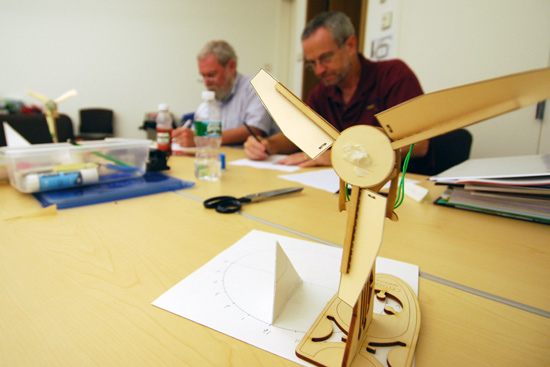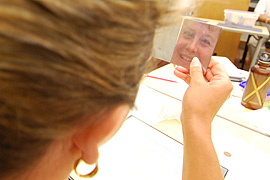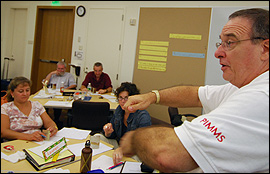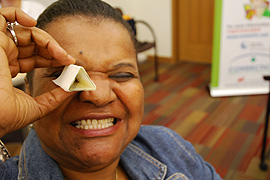PIMMS Takes Teachers Back to School
 |
 Creating educational science projects, such as building a wood windmill (top) and using mirrors to teach math (right) were part of the Summer Energy Education Workshops, sponsored by Wesleyans Project to Increase Mastery of Mathematics and Science program. Connecticut teachers learned hands-on activities to use in their own classrooms. Creating educational science projects, such as building a wood windmill (top) and using mirrors to teach math (right) were part of the Summer Energy Education Workshops, sponsored by Wesleyans Project to Increase Mastery of Mathematics and Science program. Connecticut teachers learned hands-on activities to use in their own classrooms. |
| Posted 08/06/08 |
| At 8:30 a.m., Rusty Gray wrapped an ice cube in thermal insulated foam, packaging together peanuts, bubble wrap, newspaper and aluminum foil, and placed the ice in a cooler.
Six and a half hours later, Gray removed the insulating layers and learned her method was not an adequate way to prevent ice from thawing. Gray, a fourth grade teacher at Mitchell Elementary School in Woodbury, Conn. was one of 130 elementary school teachers from around Connecticut participating in Summer Energy Education Workshops through Wesleyans Project to Increase Mastery of Mathematics and Science program (PIMMS). The ice challenge was just one science-and-energy-related experiment taught at the workshop. Our ice melted the third least amount, so we did ok, but the group that packaged their ice in sawdust did the best, Gray explained. And it makes sense that sawdust would work. Remember that before refrigeration was invented, ice was packed in an ice house with sawdust as an insulator. The workshops, which began July 18, are backed by eeSmarts, an energy efficiency and clean, renewable energy learning initiative. Supported by the Connecticut Energy Efficiency Fund and administered by the United Illuminating and Connecticut Light and Power companies, the vision of eeSmarts is to facilitate students understanding of the science, math and technology related to clean, renewable energy and electricity in order to create an energy-efficient ethic among all school-age students in Connecticut.
Energy efficiency is high on everyones priority list, Zebarth said. These workshops are meant to be interactive, cross-disciplined and activity-based lessons that teachers can use to teach children about energy and conservation. EeSmarts gives PIMMS an opportunity to strengthen science education while helping the environment. Donna Liebman, a library media specialist at the Hooker Elementary School in Hartford (pictured below, right), enjoyed crafting a three-sided kaleidoscope and working with various mirror experiments during the advanced summer institute workshop July 16.
During the two-day-long workshop, Liebman and her peers also experimented with shadows and sundials, calculating rock sizes, building a motor, building a windmill, a recycling challenge among other projects. Harvey Pond, a fourth-grade teacher at Orchard Hills Elementary School in Milford, Conn. has 37 years of teaching experience; however, dozens of the experiments taught at the workshop were new to him. I teach energy and electronics, and Ive always done the normal experiments like switches and light bulbs, but here Ive gotten so many more ideas that will really excite the kids, Pond said. Im planning on using all of them because they are all fun experiments, and they all make you think and question what it is youre doing. Funding for the eeSmarts program is derived from the monthly Combined Public Benefits Charge on consumers electric bills. |
| By Olivia Drake, The Wesleyan Connection editor |


 The sessions were taught by Bob Borello, associate director of science for PIMMS (pictured at left); Karen Calechman, eeSmarts program coordinator for PIMMS; and Barbara Austin, consultant and presenter for PIMMS. Mike Zebarth is director of PIMMS.
The sessions were taught by Bob Borello, associate director of science for PIMMS (pictured at left); Karen Calechman, eeSmarts program coordinator for PIMMS; and Barbara Austin, consultant and presenter for PIMMS. Mike Zebarth is director of PIMMS.  I love PIMMS because they always offer such fun, educationally enriching topics correlated to standards useful for todays educator, Liebman said. Here, were learning theories of science through a hands-on curriculum. Were learning how relevant topics can be taught in a fun way so students can understand how to utilize concepts every day.
I love PIMMS because they always offer such fun, educationally enriching topics correlated to standards useful for todays educator, Liebman said. Here, were learning theories of science through a hands-on curriculum. Were learning how relevant topics can be taught in a fun way so students can understand how to utilize concepts every day.